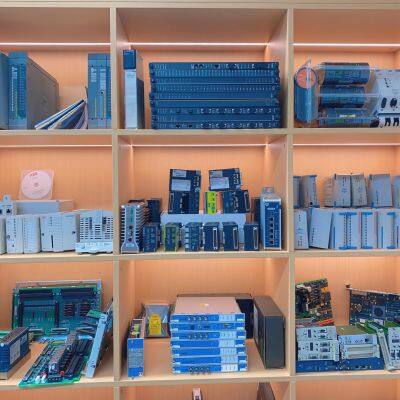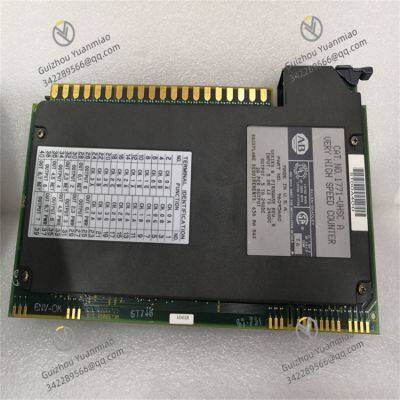Product Description
I. Product Overview
Allen - Bradley 1771 - VHSC is a high-performance high-speed counter module belonging to the Allen - Bradley PLC - 5 series. In the field of industrial automation control, it is mainly used for accurate acquisition, counting and processing of high-speed pulse signals, and is a key component for realizing functions such as high-precision position control and speed measurement. It can receive high-speed pulse signals output from devices such as encoders and tachogenerators, and convert these signals into data recognizable by the PLC processor, providing the control system with accurate position, speed and other information. It plays an important role in many industrial scenarios such as machine tool processing, packaging machinery, and conveying equipment.
From the perspective of hardware architecture, this module adopts advanced counting chips and high-speed signal processing circuits, with extremely high counting accuracy and fast signal response capability. It can accurately capture high-frequency pulse signals, ensuring accurate counting of high-speed changing pulse signals. It integrates independent counting channels and signal conditioning circuits internally, which can effectively suppress electromagnetic interference in industrial sites, ensure the stability and reliability of counting data, and maintain a good working state even in complex electrical environments.
In terms of structural design, the module adopts a standardized module structure matching the 1771 series I/O enclosures. It has a compact size and can be conveniently installed in 1771 series I/O enclosures, working together with other modules to form a complete control system. The shell is made of industrial-grade high-strength materials, with good anti-vibration and anti-impact performance, which can adapt to the mechanical environment of industrial sites and ensure the long-term stable operation of the module. At the same time, the heat dissipation design of the module is reasonable, which can timely dissipate the heat generated during operation, avoiding the impact of overheating on counting performance.
II. Performance Parameters
(1) Electrical Characteristics
Power Requirement: The working power of the module is provided by the backplane of the 1771 series I/O enclosures, usually +5V DC and +24V DC. +5V DC is mainly used to power the internal logic circuits of the module, and +24V DC is used for isolation and conditioning of external signals. The power consumption is low, which will not cause excessive burden on the power supply of the I/O enclosures, ensuring stable output of the system power supply and providing reliable power support for the normal operation of the internal circuits of the module.
Number of Counting Channels: It has 4 independent high-speed counting channels, which can collect and count 4 high-speed pulse signals at the same time, meeting the requirements of medium and large industrial control systems for the number of high-speed pulse signal acquisitions, and can be flexibly applied to different control scenarios.
Counting Range: Each counting channel has a wide counting range, usually from -2147483648 to +2147483647 (32-bit signed integer), which can meet the range requirements for high-speed pulse counting in most industrial applications and is suitable for counting scenarios of long-term and large numbers of high-speed pulse signals.
Maximum Counting Frequency: It supports an extremely high counting frequency, usually up to 500kHz, which can quickly respond to high-frequency pulse signals, accurately capture changes in pulses, ensure accurate measurement of the position and speed of high-speed moving equipment, and is suitable for industrial control occasions with extremely high requirements for counting speed.
(2) Interface Characteristics
Pulse Input Interface: Equipped with 4 independent high-speed pulse input interfaces, using screw terminal connection mode, the wiring is firm and reliable, and easy to install and maintain. The interface supports differential signal input and single-ended signal input, which can effectively resist external electromagnetic interference and ensure stable transmission of pulse signals. Each input interface has a clear identification corresponding to the corresponding channel number, which is convenient for technicians to perform wiring operations.
Backplane Interface: It communicates with the PLC processor through the backplane interface of the 1771 series I/O enclosures, and transmits the counting results to the PLC processor. The backplane interface adopts a reliable electrical connection design to ensure the timeliness and accuracy of data transmission, making the module and the PLC system form an organic whole to collaboratively complete high-speed pulse counting and control tasks.
(3) Environmental Adaptability
Operating Temperature: The operating temperature range of the module is 0°C to 60°C (32°F to 140°F), which can adapt to the temperature environment of most industrial production workshops. In high-temperature environments, stable counting performance can be maintained through a reasonable heat dissipation structure; in low-temperature environments, the internal circuit can also start and run normally, ensuring the continuity of counting work and the stable progress of industrial production.
Storage Temperature: In the storage state, it can withstand extreme temperatures from -40°C to 85°C (-40°F to 185°F), which can meet the temperature requirements of the product in transportation, storage and other links, ensuring that the module can still be used normally after long-term storage without performance degradation or damage due to temperature issues.
Anti-Electromagnetic Interference: It meets industrial-grade electromagnetic compatibility standards and has strong anti-electromagnetic interference capabilities. Through internal electromagnetic shielding and filtering circuits, it can effectively resist electromagnetic interference generated by equipment such as motors, frequency converters and electric welders in industrial sites, prevent counting errors caused by interference to pulse signals, and ensure the reliability of high-speed pulse counting.

III. Functional Characteristics
(1) High-Precision High-Speed Pulse Counting Function
The core function of the 1771 - VHSC module is to realize high-precision counting of high-speed pulse signals. It can accurately receive high-speed pulse signals from devices such as encoders, count the rising edge, falling edge or both edges of the pulses, and perform data processing according to preset counting modes (such as incremental counting, decremental counting, bidirectional counting, etc.) to obtain accurate counting results. The module has high counting accuracy, and can ensure the accuracy of counting results even when the frequency of pulse signals is extremely high, providing reliable position, speed and other data support for the PLC system.
(2) Flexible Counting Mode and Trigger Function
The module supports multiple counting mode settings. Users can configure the counting mode of each counting channel through programming software according to actual application requirements. At the same time, the module also has a flexible trigger function, which can preset multiple comparison values. When the counting result reaches the preset comparison value, the module will generate a trigger signal to trigger the action of external equipment or interrupt the program execution of the PLC, realizing high-precision position control and synchronous control. For example, in packaging machinery, when the counting result reaches the preset value, the cutting device is triggered to act, realizing precise control of the packaging length.
(3) Signal Filtering and Conditioning Function
In view of the complex electromagnetic environment and possible noise interference in industrial sites, the 1771 - VHSC module has powerful signal filtering and conditioning functions. The internal filtering circuit can effectively filter out high-frequency noise and interference in the input pulse signal, ensuring that the collected signal is pure and stable; the signal conditioning circuit can condition pulse signals of different amplitudes and types to adapt to the requirements of the internal circuit of the module, improving the compatibility and adaptability of the module to different types of pulse signals.
(4) Diagnosis and Status Indication Function
The module is equipped with perfect diagnosis function and status indication function, which is convenient for technicians to monitor the operation status of the module and troubleshoot faults. The module is equipped with power indicator lights, running indicator lights and status indicator lights for each counting channel. The power indicator light is on, indicating that the module is powered normally; the running indicator light is flashing, indicating that the module is working normally; when a certain channel is counting or fails, the corresponding status indicator light will change accordingly, so that technicians can intuitively understand the working status of each channel. At the same time, the module can also diagnose its own fault status, such as power failure, internal circuit failure, abnormal pulse signal, etc., and transmit the fault information to the PLC processor, facilitating the system to perform fault alarm and handling.
IV. Installation Steps
Preparation before Installation: Before installation, check whether the appearance of the module is intact, whether there is damage, deformation, or component falling off, and confirm that the pulse input interface and backplane interface are intact. Ensure that the power supply of the 1771 series I/O enclosures is turned off, and prepare necessary installation tools such as screwdrivers and wire strippers. At the same time, plan the wiring scheme between the external pulse equipment and the module, and select wires of appropriate specifications.
Module Installation: Align the 1771 - VHSC module with the idle slot of the 1771 series I/O enclosure, push it in smoothly along the guide rail until the module is in close contact with the enclosure backplane. Use the fixing screws on the module to firmly fix it on the enclosure to prevent loosening due to vibration during operation, which may affect signal transmission and module stability.
Wiring Connection: According to the interface identification of the module and the wiring requirements of the external pulse equipment, connect the pulse signal line of the external equipment to the corresponding pulse input interface of the module. When wiring, ensure that the wires are firmly connected to the terminals to avoid loosening or poor contact. At the same time, pay attention to distinguishing the positive and negative poles of the pulse signal and the polarity of the differential signal, and connect the lines correctly to prevent module damage or counting errors caused by wrong wiring.
Power-On Configuration and Testing: After completing the wiring, turn on the power of the I/O enclosure, and the power indicator of the module should be on, indicating that the module is powered normally. Configure the module parameters such as counting mode, comparison value, filtering parameters through programming software. After configuration, start the external pulse equipment, observe whether the running indicator of the module and the status indicator of the counting channel change normally, monitor the counting result through the programming software, and verify whether the counting function of the module is normal.


DEIF DLQ144-PC-NB Multi-Function Controller
VANGUARD PSMU-350-3 CPCI-350Q-P-38 Power Supply
Prosoft 202-DFNT-MCM4 Communications Module
Prosoft 5202-DFNT-MCM4 Communications Module
Emerson KJ4110X1-BA1 Programmable Logic Controller
ABB 1MRB15004R0001 Communication Module
ABB 1MRB150005R0001 Digital I/O Module
HIMA 80105 984080105 Communication Module
ABB 1MRK001967-AA Control Card
ABB 1MRB150020R1102 Ccontroller Module
ABB 1MRB150038R1 Power Supply Module
ABB 1MRB150051R1 Power Supply Module
ABB PPD513A-23-111615 magnetic excitation controller
TRICONEX Safety Instrumented System (SIS) 4351B control module
Bentley Nevada 3500/22M Transient data interface module
Bently Nevada 3500/15-05-05-00 power module
Triconex 3009 processor module
ABB GFD563A102 3BHE046836R0102 Excitation Convection Interface Module
ABB PPD117A3011 3BHE030410R3011 Excitation Controller
ABB PCD231B101 3BHE025541R0101 Excitation Unit Controller
ABB 5SHY3545L0010 3BHE009681R0101 High-Voltage Thyristor Module
ABB PCD230A 3BHE022291R0101 Controller Module
ABB 5SHY3545L0009 3BHB013085R0001 IGBT Module
Bently Nevada 3500/25 enhanced key phase module
 yezi
Hi there! Welcome to my shop. Let me know if you have any questions.
yezi
Hi there! Welcome to my shop. Let me know if you have any questions.


